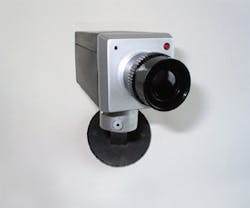IP Megapixel Cameras and Network Applications
Megapixel IP cameras are best suited to provide coverage of a large area with greater clarity. These cameras range from 1.3 to 16 megapixels, commonly grouped into two functional categories:
- 1- to 2-megapixel IP cameras, which offer excellent resolution without placing high demands on network bandwidth, making them well suited for Ethernet networks.
- High-definition megapixel IP cameras, which operate in the 5- to 16-megapixel range and are useful in applications that require few cameras and great detail with large storage capacities. However, they are not suited to wireless environments due to high bandwidth requirements.
Benefits of High-Resolution IP Cameras
Megapixel IP cameras have a clear-cut image quality advantage over traditional analog cameras. A frame of megapixel video has 5 to 12 times the number of pixels as a frame of traditional video, which translates into increased resolution across larger distances. Software applications can also clarify, zoom, and enhance the digital image at targeted small viewing areas within the image.
In many applications, a megapixel IP camera can cover the same area as an analog camera, but with improved visual clarity. In other applications, a megapixel IP camera can cover more area than a CCTV camera, so you can replace multiple CCTV cameras with a single megapixel camera.
Some latest-generation megapixel IP cameras feature "intelligent" frame rate and image compressions, which enable the camera to transmit only the portion of a previously sent image that changed. This feature greatly limits the drain on network bandwidth and reduces required storage capacity.
However, megapixel IP cameras are still more expensive than analog cameras. But, at a system level, fewer megapixel cameras are required, so the cost of system deployment can be substantially lower. If your goal is to simply replace all analog cameras in a system with megapixel IP cameras, the cost may be higher.
Utilizing IP Cameras in a Wireless Network Environment
The convenience of plugging a 1- to 2-megapixel IP camera into your existing data network and viewing the images from anywhere is compelling. Virtually any IP camera can be integrated into an existing data network using a standard Ethernet connection.
This application enables camera deployment to become incident-driven: For example, if there have been a series of muggings or vandalism in a section of a building, you can easily install a covert wireless IP camera to cover the area.
With an existing WiFi network, you can place megapixel IP cameras beyond the wired infrastructure with a battery pack or solar recharger. Any IP camera can be plugged into a wireless transponder, and they start transmitting images to create a wireless surveillance network.
Even existing analog cameras can be integrated into a digital network by installing an analog-to-digital encoder between the coax termination and the digital network, although this option can be costly, and the quality will be that of standard analog images.
Perry L. Schwartz ([email protected]) is a Freehold, NJ-based public safety consulting engineer and CTO of Intertech Associates. Patti Carlisle D’Andrea ([email protected]) is business development director at Intertech Associates.
